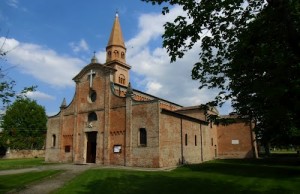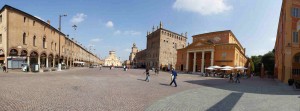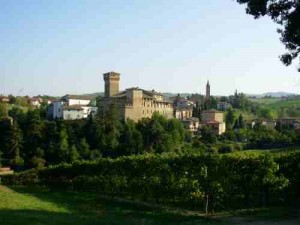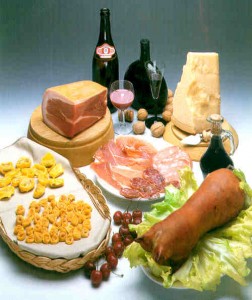Il Lambrusco, grande vino dell’ EmiliaLambrusco, a great wine from EmiliaЛамбруско, великое вино из ЭмилииLambrusco, mare vin de Emilia
Lambrusco modenese

Il Lambrusco modenese, col suo bel colore rosso rubino brillante e la sua piacevole frizzantezza, è un prodotto tipico della terra emiliana che da sempre è sinonimo di semplicità, genuinità ed accostamento con la buona tavola. Scopriamo insieme le origini e le caratteristiche del Lambrusco, in
un viaggio che parte dal cuore dell’Emilia per raggiungere anche i luoghi più lontani dell’Italia e del mondo.
Il Lambrusco ha una storia antichissima, che già i letterati dell’epoca romana come Catone, Virgilio e Varrone descrissero nelle loro opere. Diversi autori classici infatti portano la testimonianza dell’esistenza, nel territorio emiliano, di un vitigno selvatico denominato “Labrusca vitis”, che cresceva negli ambienti più marginali delle campagne coltivate e che aveva la particolarità di produrre un’uva dal gusto spiccatamente aspro.

Zona di produzione del Lambrusco modenese
La viticoltura del modenese è la più antica di tutta l’Emilia Romagna, e si vanta anche del primato di ospitare la più antica cantina sociale italiana ancora in attività (Cantina Sociale di Carpi) e, come se non bastasse, altre tre fondate più di un secolo fa. Attualmente la superficie vitata si estende per un’area di circa 8000 ettari, ed è volta alla produzione di quattro tipi di Lambrusco:
di Sorbara
Salamino di Santa Croce
Grasparossa di Castelvetro
di Modena
Per i primi tre Lambruschi (di Sorbara, Salamino di Santa Croce e Grasparossa di Castelvetro) la DOC(Denominazione di Origine Controllata) venne assegnata nel 1970 ma, per via delle recenti modifiche alla legge, ora la DOC è stata convertita in DOP (Denominazione di Origine Protetta).
Ultimo arrivato, ilLambrusco di Modena si fregia della DOP da poco tempo, essendo questa denominazione stata assegnata solo nel 2009; tutti questi Lambruschi sono valorizzati e tutelati dal Consorzio Marchio Storico dei Lambruschi Modenesi (vedi link in fondo alla pagina).
Vediamo nel dettaglio le caratteristiche dei quattro differenti Lambruschi DOP riuniti nella categoria “Lambrusco modenese”.
Lambrusco di Sorbara

Questo vino viene ricavato dal vitigno omonimo, conosciuto appunto come Lambrusco di Sorbara, coltivato nella zona compresa fra i fiumi Secchia e Panaro: si tratta di una varietà indigena di origini antichissime, esclusiva del modenese e dalle caratteristiche molto particolari. I grappoli del
Lambrusco di Sorbara sono infatti caratterizzati da un elevato grado di acinellatura, ovvero tendono a produrre molti acini delle dimensioni di pochissimi millimetri.
Questo aspetto determina la scarsità complessiva della produzione, dal momento che l’acinellatura produce dei grappoli “striminziti”: in alcuni anni la quantità di uve prodotte è davvero ridotta. Ma tutto ciò viene compensato dall’elevatissima qualità del prodotto finale: le viti, infatti, riescono a concentrare negli acini “normali” tutte le preziose sostanze nutritive, rendendole profumate e saporite in modo unico. La produzione massima per ettaro è di 18 tonnellate di uva, mentre la resa in vino dell’uva stessa non deve superare il 70%.
Per la produzione del Lambrusco di Sorbara devono essere utilizzate almeno per il 60% le uve dell’omonimo vitigno, con eventuali aggiunte di Lambrusco Salamino (per un massimo del 40%) e di altri Lambruschi, da soli o congiuntamente, fino a un massimo del 15%. Il Lambrusco di Sorbara viene prodotto nelle quattro diverse tipologie “rosso spumante”, “rosato spumante”, “rosso frizzante” e “rosato frizzante”.
Il Lambrusco di Sorbara, sia esso “frizzante” o “spumante”, è caratterizzato da un colore rosso (o rosato) rubino chiaro, ed è in assoluto il vino più chiaro fra le quattro varietà di Lambrusco modenese DOP. A causa dei suoi bei riflessi violacei, il Lambrusco di Sorbara è conosciuto anche come
“Lambrusco della Viola”.
Nel caso degli “spumanti”, la sua spuma è leggermente rosata e il profumo è fine, fresco e fruttato, e si presenta all’olfatto una nota di violetta che lo rende inconfondibile. Il sapore è armonico, fruttato e leggermente acidulo, poco corposo e delicato, che rende questo vino adatto ad essere gustato
da giovane. Si può trovare inoltre nelle tipologie secco (o asciutto), abboccato (o semisecco), amabile e dolce. Il titolo alcolometrico volumico totale minimo per la tipologia “spumante” è di 11°, con un’acidità totale minima di 6 grammi su litro; per il “rosso” l’estratto non riduttore minimo è di 18 g/l,
mentre per il “rosato” è di 16 g/l.
I vini “frizzanti” si contraddistinguono invece per la spuma vivace, evanescente, e per il titolo alcolometrico volumico totale minimo che è di 10.5°. L’acidità totale minima è di 6 grammi su litro; per il “rosso” l’estratto non riduttore minimo è di 18 g/l, mentre per il “rosato” è di 16 g/l.
Grazie alle sue caratteristiche ed alla tradizione che da sempre ne contraddistingue l’uso in cucina, il Lambrusco di Sorbara accompagna in modo eccellente i saporiti piatti tipici della cucina emiliana: lasagne, brasati e bolliti in particolare.
Lambrusco Salamino di Santa Croce

Viene prodotto principalmente (per un minimo dell’85%) con uve del vitigno autoctono Lambrusco Salamino, con piccole percentuali di altri vitigni come Lambrusco Ancellotta e Fortana (conosciuta localmente anche come “Uva d’Oro”), per un massimo del 15%. La zona di produzione del
Lambrusco Salamino di Santa Croce è nella porzione nordoccidentale della provincia di Modena, localizzata principalmente attorno al territorio di Carpi: proprio il nome di questo vitigno, “Santa Croce”, si riferisce ad una frazione di questo comune modenese.
I grappoli di questo vitigno sono piccoli ma serrati, con acini di colore blu-nerastro e dalla polpa succosa leggermente acidula. Il vitigno Lambrusco Salamino è caratterizzato da una ottima produttività, costante nel tempo, e la maturazione delle uve avviene nella prima decade del mese di ottobre. La produzione massima di uva per ettaro è di 19 tonnellate, mentre la resa in vino dell’uva stessa non deve superare il70%.
Il Salamino di Santa Croce viene prodotto nelle quattro diverse tipologie “rosso spumante”, “rosato spumante”, “rosso frizzante” e “rosato frizzante”.
Il Salamino di Santa Croce “spumante” si presenta con un colore rosso rubino carico dai riflessi violacei ed è corollato da una spuma del medesimo colore violaceo, vivace ed evanescente.
Il profumo è fresco, fruttato, persistente e dall’intendo aroma vinoso, che richiama i sentori della frutta matura. Il sapore è armonico, leggermente acidulo e fresco, sapido e di corpo medio, dal moderato grado alcolico; si può trovare nelle tipologie secco (o asciutto), abboccato (o semisecco),
amabile e dolce. Il titolo alcolometrico volumico totale minimo per la tipologia “spumante” è di 11°, con un’acidità totale minima di 6grammi su litro; per il “rosso” l’estratto non riduttore minimo è di 18 g/l, mentre per il “rosato” è di 16 g/l.
La tipologia “frizzante” è molto simile a quella “spumante”, ma è caratterizzata da un titolo alcolometrico volumico totale minimo inferiore, e pari a 10.5°.
Il Salamino di Santa Croce è di un vino gradevole e beverino, apprezzato anche dai palati più delicati e che si accompagna alla perfezione ai piatti locali come la pastasciutta col ragù bianco, i tortellini in brodo e gli arrosti.
Lambrusco Grasparossa di Castelvetro

Anche questo vino si ottiene per almeno l’85% dalle uve dell’omonimo vitigno, il Lambrusco Grasparossa, che a livello di impianto può essere affiancato da altri vitigni di Lambrusco, Malbo Gentile eFortana che concorrano per una misura non superiore al 15%. La particolarità unica del vitigno Lambrusco Grasparossa è che in autunno non sono solo le foglie a virare assumendo i colori rossi accesi tipici dell’autunno, ma anche il raspo e i pedicelli (cioè il sostegno principale del grappolo e ciascun peduncolo al quale sono attaccati i singoli acini).
Questo vitigno è generalmente poco produttivo, ma frugale ed in grado di adattarsi anche ai terreni più poveri come, ad esempio, quelli delle alte pianure e delle colline modenesi. La maturazione è dunque abbastanza tardiva, e la vendemmia avviene anche ad ottobre inoltrato; nei tempi passati, si vendemmiava anche verso la metà di novembre. I grappoli sono spargoli, ovvero con acini liberi e radi, di un colore blu scuro-nerastro, dalla buccia consistente e dalla polpa succosa e lievemente acidula. La produzione massima di uva per ettaro è di 18 tonnellate, mentre la resa in vino dell’uva stessa non deve superare il 70%.
Il Grasparossa di Castelvetro viene prodotto nelle quattro diverse tipologie “rosso spumante”, “rosato spumante”, “rosso frizzante” e “rosato frizzante”.
La tipologia “spumante” è caratterizzata da un colore rosso rubino intenso dai bei riflessi violacei, con spuma vivace ed evanescente del medesimo colore. Il profumo è fruttato e richiama fortemente a quello dell’uva matura e delle mandorle di pesco, ed è nel suo complesso fragrante, intenso e
spiccatamente vinoso. Il sapore è armonico, intenso e leggermente fruttato, con un tipico retrogusto leggermente amarognolo; si può trovare nelle tipologie secco (o asciutto,) abboccato (o semisecco), amabile e dolce. Il titolo alcolometrico volumico totale minimo è di 11°, con un’acidità totale minima di 6 grammi su litro; l’estratto non riduttore minimo è di 18 g/l per il “rosso” e di 16 g/l per il “rosato”.
La tipologia “frizzante” è molto simile, dal punto di vista organolettico, a quella “spumante”; è tuttavia caratterizzata da un titolo alcolometrico volumico totale minimo di 10.5° e da un’acidità totale minima di 5.5 grammi su litro.

Il Grasparossa di Castelvetro è adatto ad essere servito con una grande varietà di piatti, dall’aperitivo al dolce. L’accostamento migliore è con le
pietanze saporite e sostanziose come ad esempio primi piatticon ragù, lasagne ed arrosti; un ottimo abbinamento è anche quello con i salumi ed i formaggi tipici della tradizione emiliana, ma anche con formaggi invecchiati o erborinati. A fine pasto, il Lambrusco Grasparossa di Castelvetro si
sposa bene anche con la pasticceria secca o i tipici dolci di Modena, come, ad esempio, la torta Barozzi (preparata con caffè e cioccolato fondente) e il bensone, semplice dolce simile a un grosso biscotto.
Lambrusco di Modena

Questo vino, ultimo arrivato (solo nel 2009) nella categoria dei vini Lambruschi DOP modenesi, viene prodotto utilizzando un uvaggio, ovvero una mescolanza, di diversi tipi di uve. Si parte da una “base” composta almeno per l’85% da diversi tipi di Lambrusco coltivati in provincia di Modena, mentre per un massimo del 15% è possibile utilizzare uve provenienti dai vitigni Ancellotta, Malbo Gentile e Fortana. La produzione massima di uve è di 23 tonnellate per ettaro, mentre la resa massima dell’uva in vino finito non deve essere superiore al 70%. Il Lambrusco di Modena viene
prodotto in quattro principali tipologie: “rosso spumante”, “rosato spumante”, “rosso frizzante” e “rosato frizzante”.
La tipologia “rosso spumante” è caratterizzata da un colore rosso rubino o granato, di intensità variabile, e sviluppa una spuma fine e persistente. Il suo profumo è ampio e floreale, delicato e fragrante. Il sapore può essere molto diverso a seconda dei tipi: secco (o asciutto), abboccato (o
semisecco), amabile o dolce; è comunque sempre armonico con leggeri sentori di lievito. La tipologia “rosato spumante” è invece caratterizzata da un bel colore rosato, più o meno intenso, che forma una spuma fine e persistente. Il profumo è gradevolissimo, con spiccate note fruttate e floreali. Il
titolo alcolometrico volumico totale minimo è di 11° e l’acidità totale minima di 5.5 grammi su litro per entrambe le tipologie, “rosso” e “rosato”; l’estratto non riduttore minimo è invece di 18 g/l per il “rosso” e di 16 g/l per il “rosato”.
Le tipologie “frizzanti” sono molto simili ai loro corrispettivi “spumanti”, eccezion fatta per la spuma vivace ed evanescente e per il titolo alcolometrico volumico totale minimo, che è di 10.5°.
Tutte le tipologie si adattano molto bene a pastasciutte con sughi di carne, piatti succulenti a base di carne come lombatine ed arrosti ed i salumi tipici emiliani.
da Vino in cantinaLambrusco Modenese

Lambrusco Modenese, with its beautiful brilliant ruby red color and its pleasant carbonation, is a typical product of lands of Emilia that has always been synonymous with simplicity, authenticity and combination with good food. Let’s find out the origins and characteristics of Lambrusco, in a journey that starts in the heart of Emilia to reach even the most remote places in Italy and the world. Lambrusco has an ancient history, that already the literati of the Roman Catone, Virgilio and Varrone described in their works.
Several classical authors in fact bear witness the existence, in the territory of Emilia, a wild vine called “Labrusca vitis”, which grew in the most marginal of cultivated fields and had the distinction of producing grape flavor distinctly sour.

Production area of Lambrusco Modenese
Viticulture in the Modena is the oldest of all of Emilia Romagna, and also boasts of the primacy of accommodate the oldest winery Italian still in business (Cantina Sociale di Carpi) and, as if not enough, another three founded more than a century ago. Currently the area planted covers an area of about 8000 acres, and is aimed at the production of four types of Lambrusco:
Sorbara
Salamino di Santa Croce
Grasparossa di Castelvetro
Modena
For the first three Lambruscos (Sorbara, Salamino Santa Croce Grasparossa di Castelvetro) the DOC (Denomination of Controlled Origin) was assigned in 1970 but, because of the recent changes to the law, now DOC was converted into PDO (Protected Designation of Origin). Newcomer, ilLambrusco Modena boasts the DOP for a short time, this being designation was awarded only in 2009; all these Lambruscos are valued and protected by the Consortium for the Historic Mark of Modenese Lambrusco (see link at bottom of page). Let’s see in detail the characteristics of the four different Lambruscos DOP gathered in the category “Lambrusco Modenese”.
Lambrusco di Sorbara

This wine is made from the grape of the same name, known precisely as Lambrusco di Sorbara, grown in the area between the rivers Secchia and Panaro: it is a native variety of origins ancient, exclusive of Modenese and very special characteristics. The clusters of Lambrusco di Sorbara are in fact characterized by a high degree of millerandage, or tend to produce many berries of the dimensions of a few millimeters.
This aspect determines the overall scarcity of production, since millerandage produces bunches “skimpy” in a few years the amount of grapes produced is really reduced. but all this is compensated by the very high quality of the final product: the screws, in fact, fail to concentrate in the grapes “normal” all the valuable nutrients, making scented and tasty in a unique way. The maximum production per hectare is 18 tons of grapes, and the yield of Wine grape itself must not exceed 70%. For the production of Lambrusco di Sorbara must be used at least for 60% of the grapes of the vine, with the possible addition of Lambrusco Salamino (for a maximum of 40%) and altriLambruschi, alone or in combination, up to a maximum of 15%. Lambrusco di Sorbara is produced in four different types “red spumante”, “rosé spumante”, “sparkling red” and “Rosé sparkling”. Lambrusco di Sorbara, be it “sparkling” or “spumante”, is characterized by a red (or rosé) light ruby, and it is absolutely the wine clearer between the four varieties of Lambrusco Modenese DOP.
Because of its beautiful violet Lambrusco di Sorbara is also known as “Lambrusco of Viola.” In the case of “spumante”, its foam is slightly pink and the scent is delicate, fresh and fruity, and presents smell a hint of violet that makes it unmistakable. The taste is balanced, fruity and slightly acidic, light bodied and delicate, which makes this wine fit to be eaten young. It can be found also in the types dry (or dry), the bait (or semi-dry), lovable and sweet. The minimum alcoholic strength by volume for the type “spumante” is 11 °, with a total acidity of at least 6 grams of liters; for the “red” the minimum non-reducing extract is 18 g / l, while for the “pinkish” is 16 g / l. The wines “sparkling” are characterized instead by the foam lively, evanescent, and for the title strength by volume of the total minimum amount that is 10.5 °. The minimum total acidity is 6 grams of liter; for the “Red” the minimum non-reducing extract is 18 g / l, while for the “pinkish” is 16 g / l.
Thanks to its characteristics and the tradition that has always distinguished the use in the kitchen, the Lambrusco di Sorbara excellently accompanies the tasty dishes from Emilia: lasagna, pot roast and boiled in particular.
Lambrusco Salamino di Santa Croce

It is mainly produced (for a minimum of 85%) with grape vine native Lambrusco Salami, with small percentages of other varieties such as Lambrusco and Fortana (known locally as “Uva d’Oro”), for a maximum of 15%. The production area Lambrusco Salamino di Santa Croce is in the northwestern portion of the province of Modena, mainly located around the territory of Carpi: just the name of this vine, “Santa Cross “, refers to a fraction of this town of Modena. The grapes of this variety are small but compact, with blue-black berries and pulp juicy slightly sour. The Lambrusco Salamino is characterized by a excellent productivity, consistent over time, and the maturation of the grapes takes place in the first decade of the October. The maximum production per hectare is 19 tons, and the yield of wine grape must not exceed il70%.
The Salamino of Santa Croce is produced in four different types “red spumante”, “rosé spumante “,” sparkling red “and” rosé sparkling “. The Salamino Santa Croce “spumante” shows a deep ruby red hues violet and is corollato from a foam of the same purple color, lively and evanescent. The scent is fresh, fruity, persistent and vinous dall’intendo aroma, reminiscent of the scent of ripe fruit. The taste is harmonious, slightly tart and fresh, fruity and medium-bodied, from moderate alcohol; can be found in the types dry (or dry), the bait (or semi-dry), lovable and sweet. The minimum alcoholic strength by volume for the type “spumante” is 11 °, with a total acidity of minimum 6grammi liter; for the “red” the minimum non-reducing extract is 18 g / l, while for the “pinkish” is 16 g / l. The type “sparkling” is very similar to the “spumante”, but is characterized by a title minimum total alcoholic strength by volume of less, and equal to 10.5 °.
The Salamino of Santa Croce is a pleasant and drinkable wine, also appreciated by the most delicate palates and that goes perfectly with the local dishes such as pasta with white sauce, tortellini in broth and roasts.
Lambrusco Grasparossa di Castelvetro

Although this wine you get at least 85% from grapes of the vine, Lambrusco Grasparossa, that plant-wide can be joined by other Lambrusco, Malbo Dear and Fortana that contribute to an extent not exceeding 15%. The unique feature of the Lambrusco Grasparossa is that in autumn is not only the leaves turn to hiring Reds turned typical of autumn, but also the stalk and pedicels (that is the mainstay of cluster and each stalk that is attached to the individual berries). This vine is generally not very productive, but frugal and able to adapt well to land poor as, for example, those of the high plains and hills of Modena. Maturation therefore quite late, and the harvest takes place even late October; in the past, you Also, harvesting in mid-November. The clusters are sparse, ie free and berries sparse, a dark blue-black, the thick skin and juicy pulp and slightly sour. The maximum production per hectare is 18 tons, and the yield of wine grapes it must not exceed 70%. The Grasparossa di Castelvetro is produced in four different types “red spumante”, “Rosé spumante”, “sparkling red” and “rosé sparkling”. The type “spumante” is characterized by an intense ruby red color from the beautiful violet with sparkling and evanescent of the same color. The aroma is fruity and draws heavily to that of ripe peach and almond, and is a whole fragrant, intense and distinctly vinous. The taste is balanced, intense and slightly fruity, with a typical aftertaste slightly bitter; can be found in the types dry (or dry) bait (or semi-dry), lovable and sweet. The minimum total alcohol content of 11 percent, with a total acidity minimum 6 grams of liter; minimum non-reducing extract is 18 g / l for the “red” and 16 g / l for the “rosy”. The type “sparkling” is very similar, from the organoleptic point of view, to the “spumante”; is, however, characterized by a total alcoholic strength minimum of 10.5 ° and a total acidity of minimum of 5.5 grams of liter.

The Grasparossa di Castelvetro is suitable to be served with a variety of dishes, from aperitif to dessert. The approach is better with hearty and tasty foods such as pasta with meat sauce, lasagna and roast; one good match is also the one with cured meats and cheeses typical Emilian, but even with aged cheeses or blue cheeses. After the meal, Lambrusco Grasparossa di Castelvetro you combines well with pastries or cakes typical of Modena, as, for example, the cake Barozzi (prepared with coffee and dark chocolate) and bensone, simple sweet like a big biscuit.
Lambrusco di Modena

This wine, newcomer (only in 2009) in the category of wines Lambruscos DOP Modena, is product using a blend, or a mixture of different types of grapes. It starts from a “base” composed of at least 85% by different kinds of Lambrusco grown in the province of Modena, while for a maximum of 15% you can use grapes from vineyards Ancellotta Malbo Dear and Fortana. The maximum production of grapes is 23 tonnes per hectare, while the yield Maximum grape in the finished wine must not be greater than 70%. Lambrusco di Modena is product in four main categories: “red spumante”, “rosé spumante”, “sparkling red” and “Rosé sparkling”. The type “red spumante” is characterized by a red
ruby or garnet, intensity variable, and develops a fine and persistent foam. Its scent is wide and floral, delicate and fragrant. The taste can be very different depending on the types: dry (or dry), the bait (or semi-dry), sweet or sweet; is always balanced with a hint of yeast. the type “Rosé spumante” is instead characterized by a nice pink color, more or less intense, which form a fine and persistent foam. The scent is pleasant, with strong fruity and floral notes. the total alcoholic strength minimum of 11 percent and the minimum total acidity of 5.5 grams per liter of both types, “red” and “pink”; the extract is minimum non-reducing instead of 18 g / l for the “red” and 16 g / l for “pinkish”. The types “sparkling” are very similar to their counterparts “spumante”, except for the sparkling and evanescent and the minimum total alcoholic strength by volume, which is 10.5 °. All types are very well adapted to pasta with meat sauce, succulent dishes based meat as loins and roasts and salami from Emilia.
from Vino in cantina





Leave a comment